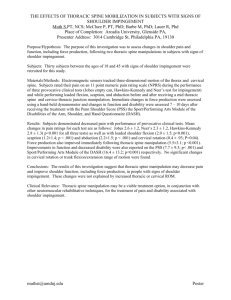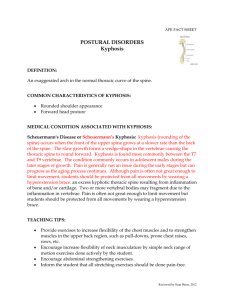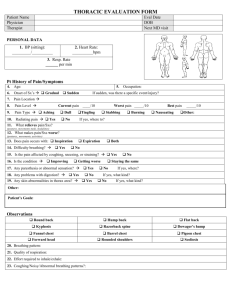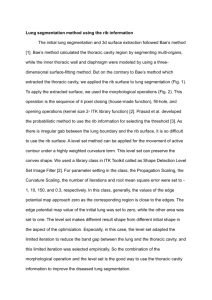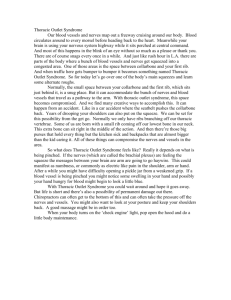Thoracic Pain Inservice
advertisement
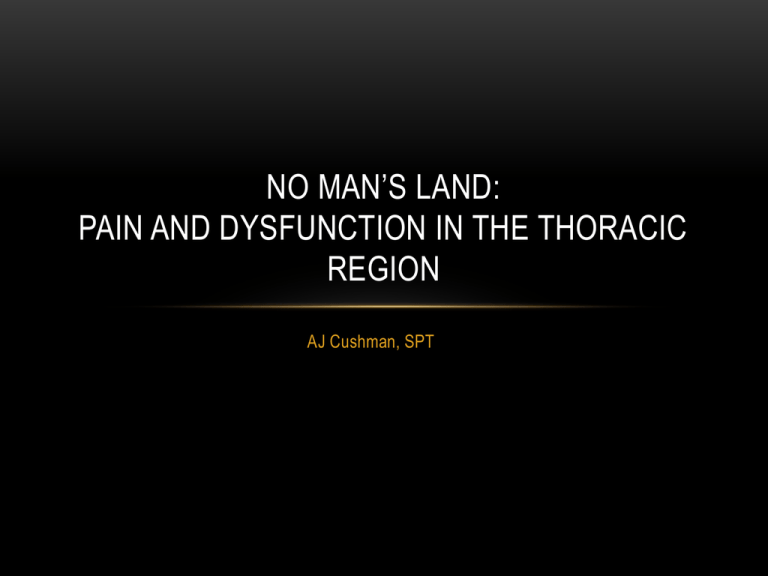
NO MAN’S LAND: PAIN AND DYSFUNCTION IN THE THORACIC REGION AJ Cushman, SPT PURPOSE • Better understand of functional connection between c-spine and l-spine • Review red flags • Referral patterns (visceral vs joint) • Associated diagnoses • Involved structures affecting thoracic spine pain and additional treatments/exercises • The effect of thoracic spine dysfunction on other areas (shoulder, neck, low back, chest wall) • Importance of proper breathing mechanics and exercises to consider • Is laughter really the best medicine? EPIDEMIOLOGY • Prevalence of musculoskeletal origin ranges from 4.0-72% • Evidence lacking in definitive answers • Most common cause = muscle irritation caused by decreased strength/poor posture • Association between cervical stenosis and thoracic stenosis • Associated with primary/secondary osteoporosis (esp vertebral fx/hyperkyphosis from bone loss), ankylosing spondylitis, OA, and Scheuermann’s disease. • Common site for inflammatory, degenerative, metabolic, infective, and neoplastic disease • Higher prevalence in kid/adolescent, W>M • Proposed: backpack weight/unilateral carry, heavy purses • Significantly associated with concurrent musculoskeletal pain; growth and physical; lifestyle and social; backpack; postural; psychological; and environmental factors RED FLAGS • Violent trauma • Minor trauma, even strenuous lifting, in people with osteoporosis • Age of onset less than 20 or over 50 (new pain) • Hx of cancer, drug abuse, HIV, immunosuppression or prolonged use of corticosteroids • Constitutional symptoms – fever, chills, unexplained weight loss • Recent bacterial infection • Structural deformity • Severe progressive neurological deficit in LE • Pain is: • Constant, severe, and progressive • Non-mechanical without relief from rest/postural changes • Unchanged after 2-4 weeks of treatment • Severe morning stiffness (rheumatoid arthritis and ankylosing spondylitis) Condition Data from interview/Hx Data from Physical Exam Stable vs Unstable Angina Pectoris Symptoms that occur w/ predictable level of exersion vs unpredictable patterns Alleviated w/ sublingual nytroglycerin vs not consistently alleviated Myocardial Infarction Reports chest pain, hx of CAD, HTM, DM-2, smoking, M>40, W>50 Palor, sweating, dyspnea, nausea, palpitations, s/s last longer than 30 min and no relief w/ sublingual nytroglycerin Pericarditis Sharp/stabbing chest pain. May refer to lateral neck or either shoulder Inc pain w/ side-lying (esp L) Dec pain w/ fwd lean in sitting (arms supported) Spinal fx Hx fall/MVA (trauma), osteoporosis, prolonged steroid use, >70, loss of func/mobility Midline tenderness at level of fx, bruising, LE neuro deficits, increased thoracic kyphosis, heel drop test, percussion test Pneumothorax Recent bout of coughing, strenuous ex, trauma Chest pain intensify w/ inspiration, difficulty expanding ribcage, hyperresonance upon percussion, dec breath RED FLAGS Condition Data from Interview/Hx Data from Physical Exam Chest, shoulder, upper abdominal pain, dyspnea, hx of, risk of DVT (Wells Prediction Rule) Dyspnea, tachynea, tachycardia Pneumonia Pleuritic pain- can refer to shoulder Fever, chills, HA, malaise, nausea, productive cough Neoplasm Unexplained wt loss, constant/progressive pain, night pain No relief w/ position changes Pleurisy “knife-like” pain w/ inspiration, hx of recent/coexisting respiratory disorder Dyspnea-dec chest wall excursion Cholecystitis (gallbladder) Right upper quadrant and scapular pain. Fever, nausea and vomiting. 1-2 hours after a fatty meal. RED FLAGS PE REFERRAL PATTERNS C-spine/T-spine Visceral JOINT REFERRAL PATTERNS T-spine zygapophyseal Joint Pain • Deep/dull ache, nauseating, boring, cramp-like • Trend for cephalad joints to be slightly more painful • Consistent pain reproduction: one segment inferior and slightly lateral • All referred inferior (no more than 2.5 segments) • No more superior than ½ segment • Unilateral only – approached, but not crossed midline • No radicular pain to ant/lat chest wall Costotransverse Joint Pain • Similar distribution, quality, severity as facet joints • Patterns unreliable in diagnosis • All joint innervated by dorsal rami • Facet = medial branches • Costotransverse = lateral branches • Costovertebral = sympathetic innervations from corresponding levels T4 SYNDROME • Includes glove-like paresthesias of one or both upper limbs, referred pain into the neck and scapular regions, and a dull, aching generalized headache. • Successful treatment has been reported in case studies using manipulation and exercise intervention • Both the thoracic intervertebral disks and thoracic zygapophyseal joints are thought to be primary pain generators costotransverse may play a role as well. OTHER DIAGNOSES RELATED TO T-SPINE Costochondritis • Assess breathing patterns and correct if necessary • Stretch/stabilize chest/scapulohumeral structures • Mobilize Thoracic outlet syndrome • Correct movement impairment • PROM for cervical musculature • Stretch! • Levator Scapulae • Scalenes • Costovertebral • Pec minor • Costosternal • Sternoclavicular • Involved ribs (most common are 4th-6th) • Potential rib mobs/MET Scheuremann’s Kyphosis • Exercise to decrease lumbar lordosis through: • Tilting of pelvis Scoliosis • Stabilize • Bracing for curves > 25-40 degrees • Promote motions opposite to lateral curvature • Postural education • Spine ROM • Hamstring stretching • Correct kyphosis by: • Foam roller • Hyperextension of thoracic spine • Correct movement impairment • Mobilize • Education • Various bracing devices may be required to help stabilize JANDA CROSSED SYNDROMES RIB INVOLVEMENT • Pump-handle vs bucket-handle • ER with elevation • Find depressed rib with inspiration – Find elevated ribs with expiration • Assess gross distraction and approximation by placing fingers between intercostal spaces and then side-bend ispilaterally and contralaterally • Joints: • Costovertebral, costotransverse, costochondral, sternocostal • Common problem areas: thoracic inlet/first rib 1ST RIB Assessing 1 st rib symmetry: • First rib MET • Scapula retraction To mobilize L 1 st rib: • Clinician places his/her own R foot on table beside patient’s R side • Patient drapes R armpit over clinician’s thigh (Patient may need to sit side-saddle with feet facing L) • Clinician places thumb on L 1 st rib • Clinician glides patient R by moving knee laterally cause patient to L SB to barrier • Pt L rotate to barrier • Pt extension barrier • Cue pt submax contraction in R fwd diagonal for 4-5 breaths keeping constant pressure on 1 st rib (May continue w/ UT stretch while maintaining pressure on 1st rib) • Draw UT posterior • Apply downward pressure • Equal + non tender = normal • Single side1/4-1/3 in higher = elevated rib • Single side 1/3-1/2 in = subluxed rib (may notice ulnar distribution neuro signs) • >1/2 in = cervical rib STERNOCLAVICULAR JOINT ASSESS • Place index finger at the proximal ends of the clavicle (sides of the sternal notch) to view symmetry • (In supines) Ask pt to shoulder shrug observe for equal inferior glide • (In supine) Ask pt to protract shoulders observe for equal posterior glide TREAT L SC jt • Bring supine pt to barrier of L shoulder flexion w/ caudal pressure to proximal clavicle • Ask pt to provide submaximal (1lb) of resistance against shoulder elevation while clinician proved caudal glide to proximal end of clavicle • 8 sec, 4-5x Exercises for Mid-thoracic dysfunction • The Brügger relief position: To prevent the tendency to hyperextend the lumbar spine with this exercise, it should be performed with active exhalation. Promotes upright posture through entire chain. • The back stretch on the ball. It promotes improved respiration. Also challenges balance. (Modification: foam roller in vertical orientation along midline while sliding arms down to 90/90) • Kolár's wall slide with arm elevation combines arm elevation, squatting and breathing. Patients may also feel stretch in lattismus dorsi with this exercise. GENERAL • MOBILIZE • Extension • Rotation • P-A mobs along vertebral segments • T-spine/C-T spine manips • CV/CT mob/manip • Stretch/strengthen where appropriate • Address trigger points • Dry needling • Ischemic compression (30-60 seconds) > strumming EFFECT OF INCREASED KYPHOSIS ON SUBACROMIAL SPACE • Increased kyphosis linked to scapular dyskinesis • decreased posterior tilt, ER, and upward rotation of the scapula • excessive scapular protraction/downward rotation • prevents elevation of acromion and increases pressure on subacromial space. • affect kinematics at glenohumeral joint • Increased kyphosis also associated with: • Decreased physical function • Respiratory function impairments • Increased cervical pain • Wall-occiput test (WOT) • Detect occult thoracic vertebral fractures • (+): Unable to touch wall with occiput while head is neutral and back and heels are against the wall. • Rib-pelvic distance test (RPDT) • Detect occult lumbar vertebral fractures • (+): <2 finger widths between inferior margin of ribs and iliac crest. • Findings: • Prevalence of thoracic kyphosis was significantly higher in subjects with subacromial impingement syndrome. Suggests influence of shoulder angle elevation. • 15 degrees of thoracic extension required for full bilateral arm elevation (9 degrees for unilateral elevation) • (+) WOT might indicate restriction in thoracic spine mobility (even though it does not evaluate thoracic extension), but only reduction in shoulder elevation (RSE) was significantly associated with SIS directly. THE INFLUENCE OF THE MOBILITY IN THE CERVICOTHORACIC SPINE AND THE UPPER RIBS (SHOULDER GIRDLE) ON THE MOBILITY OF THE SCAPULOHUMERAL JOINT • Relation between Mobility in Shoulder Girdle and Scapulohumeral Joint • Importance of the function of the clavicle for the anteflexion and abduction motions in the scapulohumeral joint. • These motions depend on function of ligamentum costoclaviculare and the musculus subclavius. • The tension in these structures will change when the first rib remains immobile restriction in mobility of the first rib can cause a restriction of mobility in the scapulohumeral joint. • Relation between Mobility in Cervicothoracic Spine and First Rib (Shoulder Girdle) • 1st rib mobility restriction during inspiration associated with Thoracic Outlet Syndrome • Costoclavicular, anterior/middle scalene, pectoralis minor, cervical rib • To test for restriction in mobility: • Cervical rotation later flexion test (CRLF test) • Expiration Inspiration test. • In 28/32 patients with 1 st rib restriction, rotational restriction combined with twisting at C7-T1 was detected CRLF test Expiration Inspiration test • Relation between Mobility in the Spine and the Scapulohumeral Joint • Rotation between C6 and T4 toward the anteflexion side is necessary for an anteflexion motion of the arm • Restriction of mobility of the cervicothoracic spine disturbances in this anteflexion motion • Observe a restriction in anteflexion and/or complaints caused by a much stronger participation of the muscles involved in the motion CHRONIC NECK PAIN IN YOUNG ADULTS: PERSPECTIVES ON ANATOMIC DIFFERENCES • To identify anatomical predictors for chronic neck pain (NP) using MRI • Sagittal alignment • Dimension of thoracic inlet (manibrium, first rib, T1, etc) • Depth of T1-manubrium arch (T1AD) (mm) = midsagittal distance between top of the manubrium and the tip of T1 spinous process • Thoracic inlet inclination (TiI) (degrees) = Angle between lines drawn along top of manubrium to center of superior aspect of T1 end plate and horizontal • Both T1AD and TiI were identified as predictors for NP in binary logistic regression analysis OTHER C-SPINE CONSIDERATIONS Region-specific history • “Do neck movements improve your symtptoms?” (+LR) of 2.2, (-LR) or 0.5 • “Where is the pain most bothersome?” If answer “shoulder/scapula area,” (+LR) 2.3 EVALUATING KYPHOSIS AND LORDOSIS IN STUDENTS BY USING A FLEXIBLE RULER AND THEIR RELATIONSHIP WITH SEVERITY AND FREQUENCY OF THORACIC AND LUMBAR PAIN • Lumbar arch was 34.46°±12.61° and 22.46°±9.9° in female students and male students, respectively. Lumbar lordosis showed a significant difference between the two student groups (p<0.001), • No difference in the thoracic curvature (p=0.288) • No significant relationship was observed between kyphosis and inter-scapular pain (p=0.946) • Significant relationship between lordosis and lumbar pain severity (p=0.006). THE EFFECTIVENESS OF NONINVASIVE INTERVENTIONS FOR MUSCULOSKELETAL THORACIC SPINE AND CHEST WALL PAIN: A SYSTEMATIC REVIEW BY THE ONTARIO PROTOCOL FOR TRAFFIC INJURY MANAGEMENT (OPTIMA) COLLABORATION • Lehtola et al randomized females with thoracic spine pain (≤ 3-month duration, T3-T8). Interventions performed 4x/week for 3 weeks • (1) high-velocity thrust spinal manipulation, • (2) needle acupuncture, or • (3) placebo electrotherapy with intermittent suction. • Results: small statistically significant differences in pain reduction favoring manipulation 1-week postintervention. No significant difference in long term outcome. • Stochkendahl et al randomized recent-onset anterior chest wall pain (<7 days) to • (1) Receive a multimodal program of care OR • (2) Consultation with a chiropractor • Statistically significant improvement in “worst chest pain” reduction favoring the multimodal care, however, change was not clinically important. Also more likely to report chest wall pain was “better or “much better” in short term. • **(Study weakness: DOSAGE) THE IMMEDIATE EFFECT OF THORACIC SPINE AND RIB MANIPULATION ON SUBJECTS WITH PRIMARY COMPLAINTS OF SHOULDER PAIN • Relative contribution of specific manipulative techniques applied to the cervical spine, thoracic spine, and/or ribs. • Report the immediate effects only • Exclusion: diagnostic evidence of rotator cuff tear • VAS pain intensity scores decreased by 32mm post-treatment (p<0.01), thus surpassing the MCID of 12mm 25. BREATHING • Breathing glides the median nerve 1 inch • Influences sympatho-vagal balance • Dysfunctional breathing can induce hypocapnia (from hyperventilaiton) • Increased neural activity/synaptic tranmission • linked to muscle tightness and resting tone • Breathing mechanics • Diaphragmatic breathing benefits: relaxation, mobility, and core activation. • Using breath with core in natural, more efficient pressurized stability than isolated transverse abdominis. IMPORTANT ANATOMICAL COMPONENTS • Diaphragm: RESPIRATION AND STABILITY…should be able to perform this dual function all the time • • Abdominals and pelvic floor • • With poorly trained system, diaphragm loses stabilizing function to focus on respiration with increased activity/exertion inability to control intra-abdominal pressure (IAP)INJURY! During inspiration these muscle contract eccentrically to increase intra-abdominal pressure Thoracic Cavity • Where the magic happens… • Must have enough mobility available to accommodate pressure change/molecule flow • Ribs ER and spine extends • Breathing hydrates thoracic disc with ribs acting as a lever to pry open thoracic spine with each breath CHECK YOURSELF • Ideal pattern at rest = slow, light, mainly abdominal breathing increases oxygenation of human body. • >12 diaphragmatic breaths per minute w/ about 500mL per breath OR deep diaphragmatic breathing that causes CO2 losses = hyperventilation • Reduces O2 delivery to vital organs • Test predominant automatic breathing technique: One hand over stomach and other over upper chest. Observe pattern for 20-30 seconds. • Exercise 1: Same position, but breath so that your rib cage/upper hand don’t move • Exercise 2: In supine, place phonebook (or equivalent weight) and abdomen. Breath so the books lift 2-3 cm without expanding the ribs. • Exercise 3: Breathing with belt around rib cage (cannot take deep inhalation with ribcage/chest. Can be done for minutes/hours. Focus enhances nervous system links to muscular control. 5 TECHNIQUES • Lateral shift correction • Push on hip with arm against wall, hold end range for 3-5 breaths (should total to 2030 seconds with proper breathing technique) • Repeated extension in lying • Improvement on “sag” overpressures, see hip drops closer to table • Extend head/neck as well to put further slack on posterior chain muscles • Open book thoracic rotation • Chronic cervical, glenohumeral, and lumbar issues • Hold upper LE down with bottom hand, and place top hand on sternum and pull in opposite direction for thoracic rotation. • Standing (or kneeling) psoas stretch • Posterior pelvic tilt, hip IR, isometric glute contraction • Standing Hamstring/Sciatic Neurodynamic Tensioner • Anterior pelvic tilt, hip adduction, IR, ankle dorsiflexion LAUGHTER YOGA: IS LAUGHTER REALLY THE BEST MEDICINE AFTER ALL?? • Compare compare muscle activation between traditional low back stabilization • Overall mean activity at highest intensity laughter yoga was comparable to traditional exercises • Internal oblique exceeded abdominal crunch by 150%. • Stronger emphasis on self-organized muscular control, where traditional exercises are controlled in a cognitive manner. • Laughter associated with presence of co-activation for back and abdominal muscles • Rhythmic, high frequency, less stereotypical REFERENCES • Briggs, Andrew et al. “Thoracic Spine pain in the general population: Prevalence, incidence and associated factors in children, adolescents and adults.” European Journal of Medical Research. June 2009. • Lee, Ji-Hye et al. “Chronic neck pain in young adults: perspectives on anatomic differences.” The Spine Journal. Vol 14, Issue 11, pages 2628-2638. 2014-11-01. • Religioso III, Erson. “5 Techniques to Try With Diaphragmatic Breathing.” The Manual Therapist: The Blog of the Eclectic Approach. Jan 2013. • Sedigheh-Sadat Mirbagheri et al. “ Evaluating kyphosis and lordosis in students by using a flexible ruler and their relationship with severity and frequency of thoracic and lumbar pain.” Asian Spine Journal. 416-422. June 2015 • Sobel, JS et al. “Review of the literature. The influence of mobility in the cervicothoracic spine and upper ribs (shoulder girdle) on the mobility of the scapulohumeral joint.” Journal of Manipulative & Physiological Therapeitcs. (7): 46974. (16 ref). Sept 1996. • Southerst, Danielle et al. “The Effectiveness of Noninvasive Interventions for Musculoskeletal Thoracic Spine and Chest Wall Pain: A Systematic Review by the Ontario Protocol for Traffic Injury Management (OPTIMa) Collaboration.” Journal of Manipulative and Physiological Therapeutics. National University of Health Sciences. 2015. • Strunce, Joseph et al. ‘” The immediate effect of thoracic spine and rib manipulation on subjects with primary complaints of shoulder pain.” The Journal of Manual & Manipulative Therapy. 17(4): 230-236. 2009. • Wagner, Helko et al. “Laughing: A demanding exercise for trunk muscles.” Journal of Motor Behavior. Vol 46, Issue 1, pages 33-37, 2014. • Young, Brian A, et al. “Thoracic costotransverse joint pain patterns: a study in normal volunteers.” BMC Musculoskeletal Disorders. Oct 2008.
